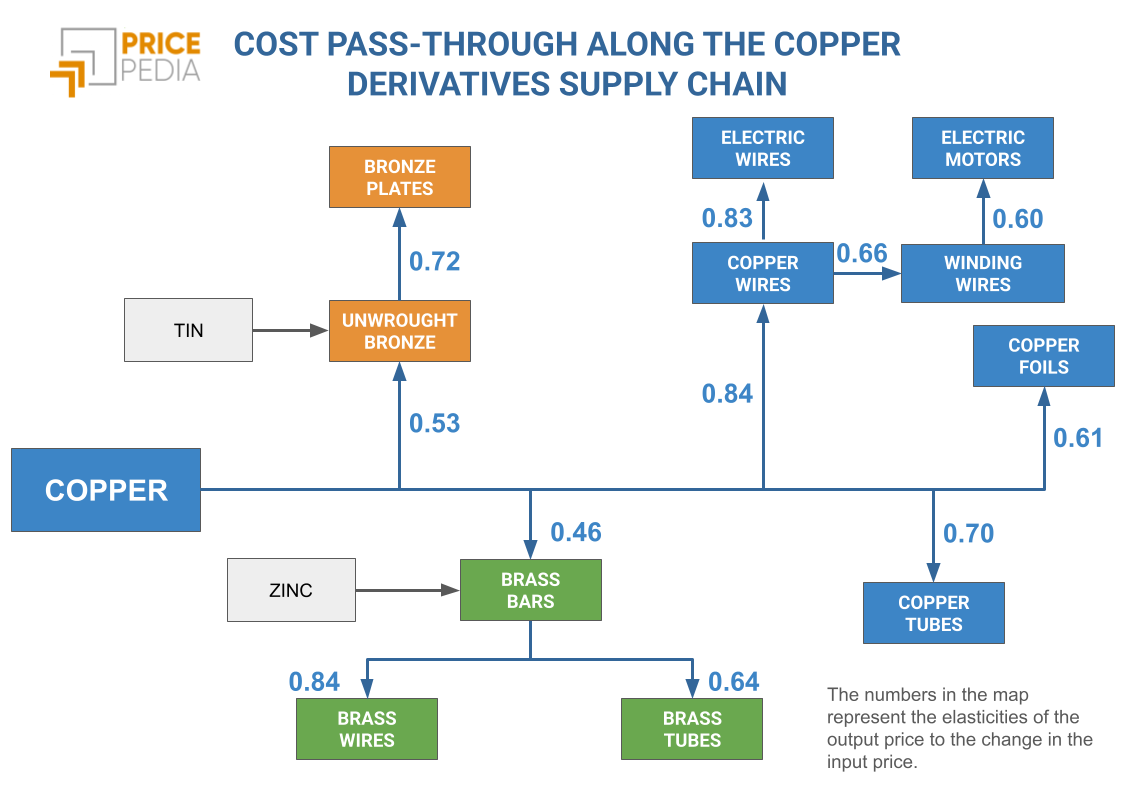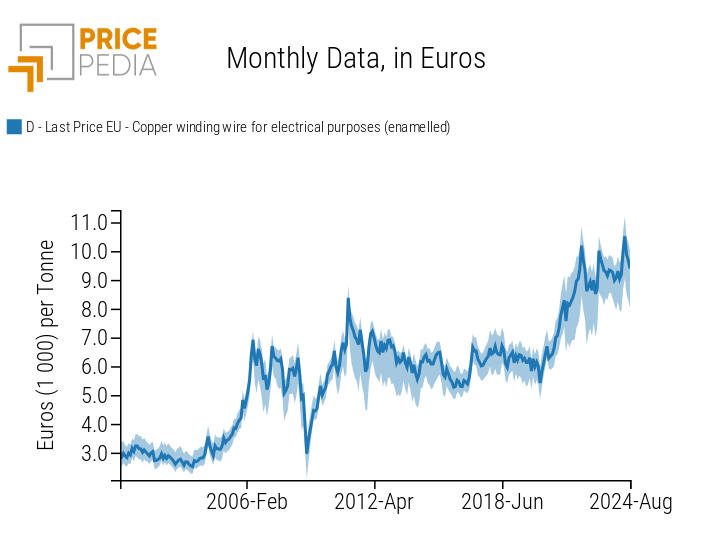Cost pass-through along the copper derivatives supply chain
How changes in copper prices are passed on to derivative prices
Published by Luca Sazzini. .
Copper Price DriversThe economic theory of cost pass-through analyzes how variations in production input costs are transferred to the final price of the output. The effect of this transfer can vary significantly depending on the degree of product differentiation and the type of market in which it is traded.
In markets with homogeneous products and perfect competition, cost pass-through tends to be complete and immediate, with total production cost transfer already in the short term. Conversely, in monopolistic competition markets with a high degree of product differentiation, cost pass-through tends to be incomplete in the short term.
Specifically, producers prefer to absorb temporary increases in production costs to ensure greater price stability and remain competitive.
In the case of a cost decrease, the optimal strategy for producers is to maintain the price unchanged, increasing profit margins while facing a limited risk of market share reduction. A concrete example of this theory was reported in the article: Analysis of margins of European coated sheet manufacturers, which highlighted how European coated sheet producers reduced their margins during 2021-2022 when the prices of hot-rolled coils, their main production input, increased, and then recovered them in the following two years when coil prices fell again.
In this analysis, we will provide cost pass-through estimation results along the copper derivatives supply chain, following the approach used in the article: Cost Pass-Through Along the Supply Chain of Propylene Chemical Intermediates.
Cost Pass-Through of Copper Prices
The cost pass-through estimation results were obtained using dynamic specification econometric models and are expressed as long-term elasticity between the price of the production input and its derivative. These results primarily depend on two theoretical factors:
- The incidence of input production costs on the output value: An increase in the incidence of input costs on the output value leads to higher elasticity between input and derivative prices;
- The degree of product differentiation: As mentioned earlier, cost pass-through between input and output prices tends to decrease (increase) as the degree of product differentiation (or standardization/uniformity) increases.
The following map shows the cost pass-through estimation results along the copper derivatives supply chain, corresponding to intersections between input and derivative prices.

From the analysis of the map depicting the price elasticity estimation results for outputs in response to input price variations, the expectations of the cost pass-through theory are confirmed. In markets with a higher degree of product differentiation, such as those of brass and bronze, the cost pass-through of copper prices tends to be lower. In these two markets, there is a higher degree of differentiation due to the specific alloy composition, which can significantly affect the final product properties. For example, in the case of brass, a higher copper content increases corrosion resistance, malleability, and workability. Conversely, a higher zinc percentage improves hardness and tensile strength but reduces malleability and corrosion resistance. The different alloy compositions allow the production of different products or at least those perceived as such by the market. A similar level of differentiation also characterizes the bronze market, where variations in copper and tin percentages create alloys with different mechanical properties suitable for specific applications.
The higher degree of differentiation results in a relatively contained cost pass-through of copper to brass bars and unwrought bronze, with values of 0.46 and 0.53, respectively. This implies that, ceteris paribus, a 10% increase (decrease) in copper prices leads to an average increase (decrease) of 4.6% and 5.3% in the prices of brass bars and unwrought bronze, respectively.
On the other hand, the price with the highest elasticity to copper prices is that of copper wires, with an estimated value of 0.84. This particularly high value is due to an almost complete and immediate cost pass-through for non-insulated copper wire types. These products have limited differentiation possibilities. In this case, their market resembles perfect competition, where producers have no market power. [1]
Do you want to stay up-to-date on commodity market trends?
Sign up for PricePedia newsletter: it's free!
Cost Pass-Throughalong the Value Chain
The map above also depicts the transmission of production costs from copper derivatives to more complex products that use these derivatives as production inputs. An example is bronze plates, whose manufacturing process involves unwrought bronze, which is itself derived from copper. In this case, since the relationship between copper prices and bronze plates prices is indirect—mediated by unwrought bronze—the effect of copper price transmission on plates costs must be calculated by multiplying the different elasticities along the production chain. In the considered example, the price elasticity of bronze plates to copper price variations is 0.38, derived from the product of unwrought bronze elasticity to copper (0.53) and the elasticity of plates to unwrought bronze (0.72).
An even more complex case is that of electric motors, whose price is determined by the cost of winding wires, which in turn depends on the price of copper wires, which ultimately follow variations in copper prices. In this case, the elasticity between copper prices and electric motor prices is 0.33, obtained as 0.84 x 0.66 x 0.6. This means that a 10% increase (decrease) in copper prices translates, on average, into a 3.3% increase (decrease) in electric motor prices.
Conclusions
This analysis provides elasticity estimates not only for copper derivatives but for the entire production chain in response to copper price variations. This approach offers an overall view of cost transmission dynamics along the value chain, enabling a deeper understanding of the economic implications of raw material price fluctuations.
The results obtained using dynamic specification econometric models are consistent with the economic theory of cost pass-through, highlighting lower cost transmission for products with a higher degree of differentiation.
[1] For a more in-depth analysis of the estimated cost pass-through of copper wires, see the article: The price transmission mechanism: how much does market structure matter?


